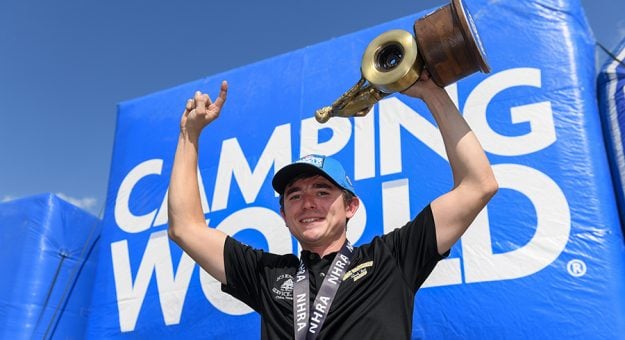“I think it’s a good thing,” Stanfield said. “The only way the NHRA or drag racing, period, continues to grow is you have to have youth. You have to have new people. Greg Anderson’s still bad to the bone, but he won’t be able to drive a Pro Stock car forever. So that knowledge has to be passed down.
“And I think it’s great that we’re seeing some youth in Pro Stock. And I’m happy and excited to be a part of it,” Stanfield added. “I think it’s important for the health of our sport. I would probably say that as far as new blood and youth, Pro Stock is the best right now. I think it is more affordable than it was when my dad raced, with the RPM limits and certain things they’ve done. It’s definitely made things more affordable.
“Pro Stock’s in a good place but way different than it has been in the past. It’s in a really good state, as far as availability of it, and we have a lot of youth in it,” Stanfield said.
Although on the surface the Pro Stock and Factory Stock Showdown classes appear to be duplicates, they are not. The equipment on Pro Stock cars is anything but “stock.” Stanfield agreed: “There’s not much, to say the least.”
He said both Pro Stock and FSS “are very expensive. Pro Stock has been refined for a really long time. Even though it changed to EFI, it’s still a 500-cubic-inch, naturally aspirated engine that’s been refined for a long time. So being that the Showdown class is new, there’s just a lot of development that goes along with it.”
And being on the cutting edge, he said, “is a lot of fun. That’s one of the reasons we enjoy it so much.
“The big difference is that the engines that we run in the Factory Stock stuff are geared to what the manufacturers sell to people,” Stanfield said. “The engine we’re running in the car, I have friends who run some of the parts in their street cars. So it’s relatable and I think the manufacturers enjoy that, not to take anything from Pro Stock. It ended up the way it ended up because of evolution, just innovating.
“It’s always a step to hop in a brand-new class, no doubt. But it’s something that we think is really important to drag racing. It’s just the fact of having the manufacturers compete against each other is something that we want to be involved in and be part of the evolution of it.”
But Stanfield stressed, “I absolutely think it’s been hard. It is hard work. I always said since I’ve started that I’ve eaten it, I’ve slept it and I’ve breathed it. And I’ve been very fortunate to be around some really good people that have helped put me in good places. We’ve had a lot of success, but we don’t like losing and we don’t like getting outrun.
“We’ve worked really, really hard in the shop. We’ve struggled and we’ve had successes. We’ve all learned together. My dad’s been there. We’ve got a couple of other young guys in the shop, Collin Jackson and Conner Statler. It’s kind of him passing down his knowledge to us and us taking it and running with it.”
Jackson and Statler are success stories from SAM Tech, the School of Automotive Machinists and Technology, which served as the Factory Stock Showdown class sponsor until Constant Aviation stepped forward.
Stanfield earned a degree in business from Louisiana State University Shreveport.
“College was a challenge,” Stanfield said, “because opportunities were starting to pop up in the drag-racing world. So I had to learn how to juggle being able to go to school and start to build a career for myself at the same time. It was something that was very important for me and I did well. I was taught to take a lot of pride in anything I ever do.
“My grandpa was the one who started teaching me everything. My dad let me make my own choice of what I wanted to do. He never really pushed me to get into it, surprisingly. I enjoyed sports as a kid and didn’t do any Jr. Dragster racing. It wasn’t until maybe right before I got my driver’s license that I really started getting into it,” he said. “My dad had already sold most of his equipment whenever he was getting out of Pro Stock. He was kind of ready to slow down and I drove him right back into it. I told him I wanted to learn, and obviously, he’s taught me a lot. I’m very thankful to have him on my side.”
The bright star for Stanfield is not where he came from but rather where he is going.
